3 scientists win Nobel physics prize for black hole research
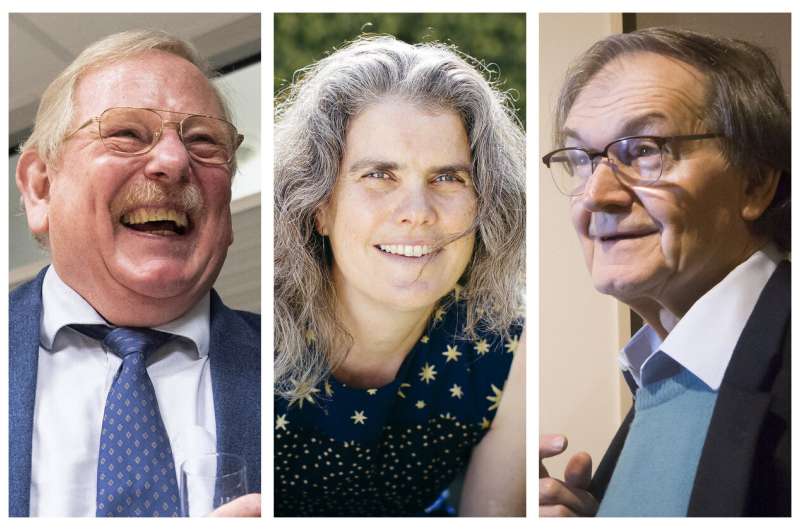
Three scientists won the Nobel Prize in physics Tuesday for establishing the all-too-weird reality of black holes—the straight-out-of-science-fiction cosmic monsters that suck up light and time and will eventually swallow us, too.
Roger Penrose of Britain, Reinhard Genzel of Germany and Andrea Ghez of the United States explained to the world these dead ends of the cosmos that are still not completely understood but are deeply connected, somehow, to the creation of galaxies.
Penrose, an 89-year-old at the University of Oxford, received half of the prize for proving with mathematics in 1964 that Einstein's general theory of relativity predicted the formation of black holes, even though Einstein himself didn't think they existed.
Genzel, who is at both the Max Planck Institute in Germany and the University of California, Berkeley, and Ghez, of the University of California, Los Angeles, received the other half of the prize for discovering in the 1990s a supermassive black hole at the center of our galaxy.
Black holes fascinate people because "the idea of some monster out there sucking everything up is a pretty weird thing," Penrose said an interview with The Associated Press. He said our galaxy and the galaxies near us "will ultimately get swallowed by one utterly huge black hole. This is the fate ... but not for an awful long time, so it's not something to worry too much about."
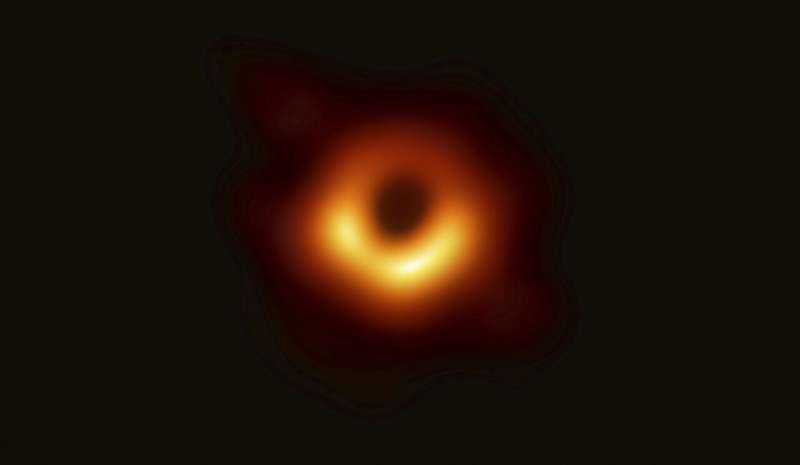
Black holes are at the center of every galaxy, and smaller ones dot the universe. Just their existence is mind-bending. They are so massive that nothing, not even light, can escape their gravitational pull. They warp and twist light in a way that seems unreal and cause time to slow and stop.
"Black holes, because they are so hard to understand, is what makes them so appealing,'' Ghez, 55, said after becoming the fourth woman ever to win a Nobel in physics. "I really think of science as a big, giant puzzle."
While the three scientists showed the existence of black holes, it wasn't until last year that people could see one for themselves when another science team captured the first and only optical image of one. It looks like a flaming doughnut from hell but is in a galaxy 53 million light-years from Earth.

Penrose, a mathematical physicist who got the call from the Nobel Committee while in the shower, was surprised at his winning because his work is more theoretical than observational, and that's not usually what wins physics Nobels.
What fascinated Penrose more than the black hole was what was at the other end of it, something called the "singularity." It's something science still can't figure out.
"Singularity, that's a place where the densities and curvatures go to infinity. You expect the physics go crazy," he said from his home. "If you fall into a black hole, then you pretty well inevitably get squashed into this singularity at the end. And that's the end."
Penrose said he was walking to work with a colleague 56 years ago, thinking about "what it would be like to be in this situation where all this material is collapsing around you." He realized he had "some strange feeling of elation," and that was when things started coming together in his mind.

Martin Rees, the British astronomer royal, noted that Penrose triggered a "renaissance" in the study of relativity in the 1960s, and that, together with a young Stephen Hawking, he helped firm up evidence for the Big Bang and black holes.
"Penrose and Hawking are the two individuals who have done more than anyone else since Einstein to deepen our knowledge of gravity," Rees said. "Sadly, this award was too much delayed to allow Hawking to share the credit."
Hawking died in 2018, and Nobel Prizes are awarded only to the living.
New York University astrophysicist Glennys Farrar said: "There is no doubt that if this prize were awarded when Hawking was still alive, he would share it. He did overall more significant work on this subject than almost anyone."
Genzel, 68, and Ghez won because "they showed that black holes are not just theory—they're real, they're here, and there's a monster-size black hole in the center of our galaxy, the Milky Way," said Brian Greene, a theoretical physicist and mathematician at Columbia University.
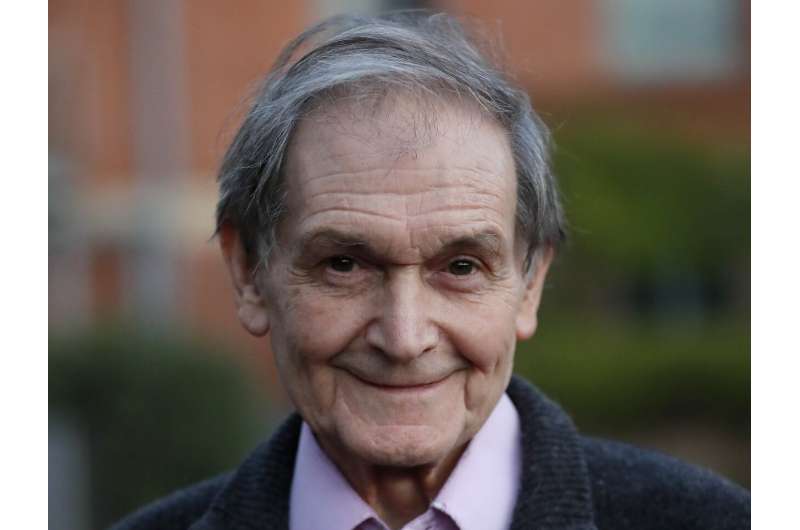
In the 1990s, Genzel and Ghez, leading separate groups of astronomers, trained their sights on the dust-covered center of our Milky Way galaxy, a region called Sagittarius A(asterisk), where something strange was going on. It was "an extremely heavy, invisible object that pulls on the jumble of stars, causing them to rush around at dizzying speeds," according to the Nobel Committee.
It was a black hole. Not just an ordinary black hole, but a supermassive one, 4 million times the mass of our sun.
The first image Ghez got was in 1995, using the Keck Telescope in Hawaii that had just gone online. A year later, another image seemed to indicate that the stars near the center of the Milky Way were circling something. A third image led Ghez and Genzel to think they were really on to something.
A fierce competition developed between Ghez and Genzel, whose team was using an array of telescopes at the European Southern Observatory in Chile.
-
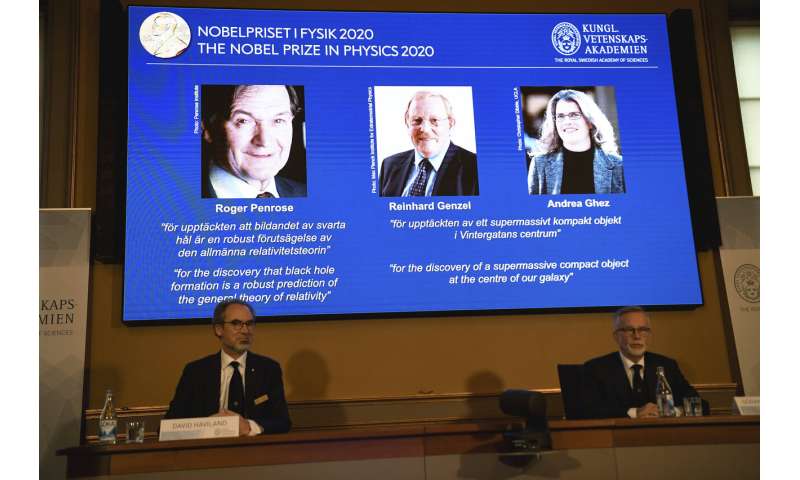
David Haviland, member of the Nobel Committee for Physics, left, and Goran K. Hansson, Secretary General of the Academy of Sciences, announce the winners of the 2020 Nobel Prize in Physics during a news conference at the Royal Swedish Academy of Sciences, in Stockholm, Sweden, Tuesday Oct. 6, 2020. The three winners on the screen from left, Roger Penrose, Reinhard Genzel and Andrea Ghez have won this year's Nobel Prize in physics for black hole discoveries. (Fredrik Sandberg/TT via AP) -
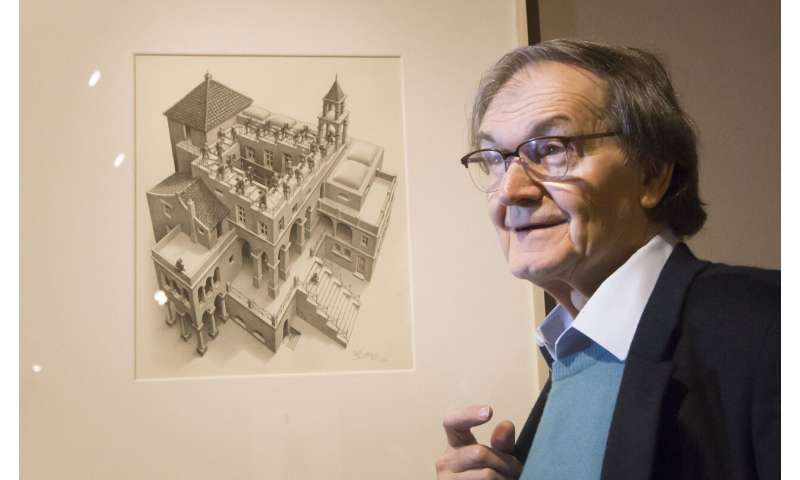
This June 26, 2015 file photo shows Roger Penrose. The 2020 Nobel Prize for physics has been awarded to Briton Roger Penrose, German Reinhard Genzel and American Andrea Ghez for discoveries relating to black holes. (Danny Lawson/PA via AP) -

Reinhard Genzel, right, astrophysicist at the Max Planck Institute for Extraterrestrial Physics, celebrates his Nobel Prize in Physics with his team in Garching, Germany, Tuesday, Oct. 6, 2020. (Matthias Balk/dpa via AP) -

Reinhard Genzel, astrophysicist at the Max Planck Institute for Extraterrestrial Physics, celebrates his Nobel Prize in Physics with his team in Garching, Germany, Tuesday, Oct., 2020. (Matthias Balk/dpa via AP) -

Host Janna Levin left, and Andrea Ghez participate in the "Black Hole Apocalypse" panel during the PBS Television Critics Association Summer Press Tour at the Beverly Hilton on Monday, July 31, 2017, in Beverly Hills, Calif. Ghez is one of three scientists awarded the Nobel Prize for Physics for discoveries related black holes. (Photo by Richard Shotwell/Invision/AP, File) -
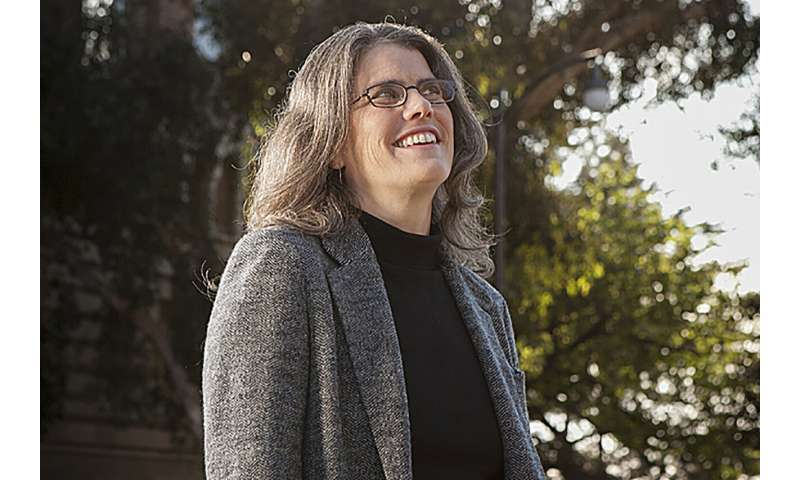
This photo dated Feb. 17, 2012, shows Andrea Ghez, professor of physics and astronomy at UCLA. Ghez was one of three scientists who won this year's Nobel Prize in physics a Tuesday, Oct. 6, 2020, for advancing our understanding of black holes. (UCLA via AP) -

Andrea Ghez, professor of physics and astronomy at UCLA, poses during an interview at the university in Los Angeles, Tuesday, Oct. 6, 2020. Ghez was one of three scientists who was awarded this year's Nobel Prize in physics on Tuesday for advancing our understanding of black holes, the all-consuming monsters that lurk in the darkest parts of the universe. (AP Photo/Aron Ranen) -
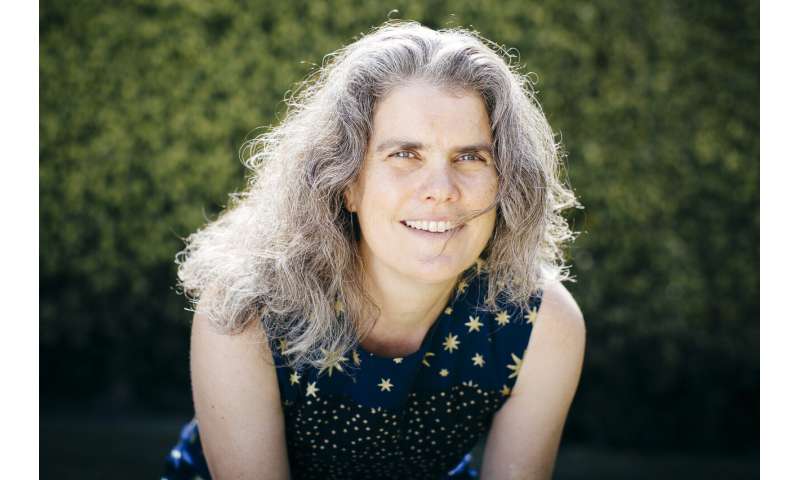
This photo dated May 30, 2015, shows Andrea Ghez, professor of physics and astronomy at UCLA. Ghez was one of three scientists who was awarded this year's Nobel Prize in physics on Tuesday, Oct. 6, 2020, for advancing our understanding of black holes, the all-consuming monsters that lurk in the darkest parts of the universe. (UCLA via AP) -
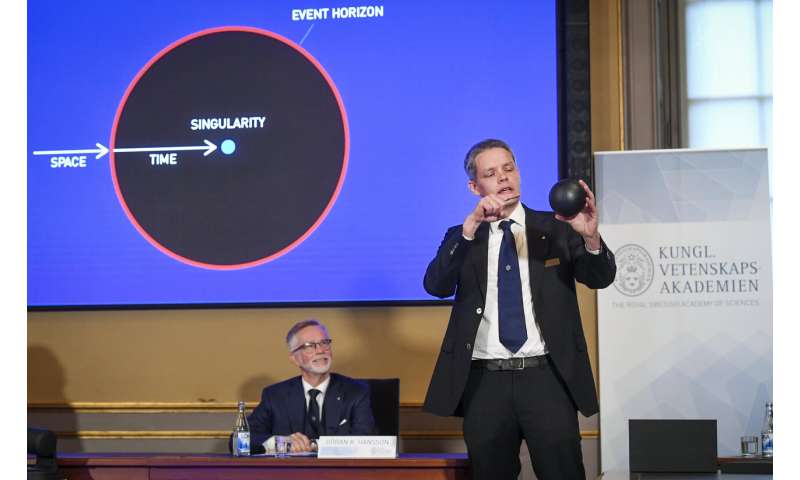
Ulf Danielsson, member of the Royal Swedish Academy of Sciences speaks after the announcement of the winners of the 2020 Nobel Prize in Physics during a news conference at the Royal Swedish Academy of Sciences, in Stockholm, Sweden, Tuesday Oct. 6, 2020. The three winners on the screen from left, Roger Penrose, Reinhard Genzel and Andrea Ghez have won this year's Nobel Prize in physics for black hole discoveries. (Fredrik Sandberg/TT via AP)
"Their rivalry elevated them to greater scientific heights," said Harvard astronomer Avi Loeb.
Unlike with other achievements honored with Nobels, there is no practical application for these discoveries.
"Is there a practical application to Beethoven's Ninth Symphony?" Columbia's Greene asked. "But its existence, this type of spectacular knowledge, is part of what gives life meaning."
The Nobel comes with a gold medal and 10 million kronor (more than $1.1 million), courtesy of a bequest left 124 years ago by the prize's creator, Alfred Nobel, the inventor of dynamite.
On Monday, the Nobel in medicine was awarded to Americans Harvey J. Alter and Charles M. Rice and British-born scientist Michael Houghton for discovering the liver-ravaging hepatitis C virus. The prizes for chemistry, literature, peace and economics will be announced in the coming days.
The Nobel Foundation announcement:
The Royal Swedish Academy of Sciences has decided to award the Nobel Prize in Physics 2020
with one half to
Roger Penrose
University of Oxford, UK
"for the discovery that black hole formation is a robust prediction of the general theory of relativity"
and the other half jointly to
Reinhard Genzel
Max Planck Institute for Extraterrestrial Physics, Garching, Germany and University of California, Berkeley, U.S.
and
Andrea Ghez
University of California, Los Angeles, U.S.
"for the discovery of a supermassive compact object at the centre of our galaxy"
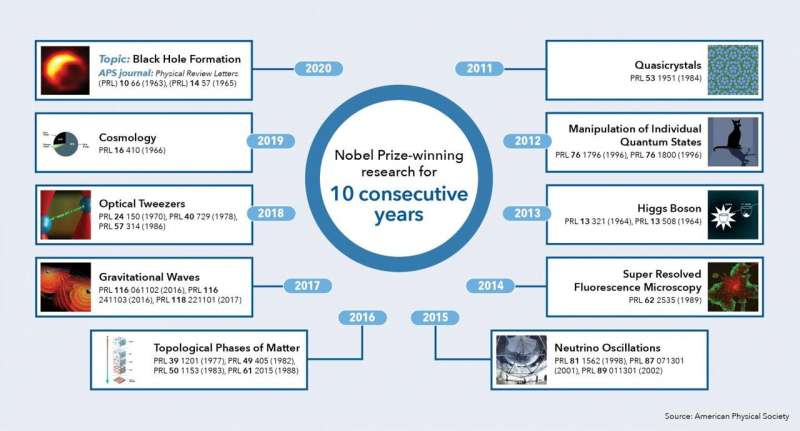
Black holes and the Milky Way's darkest secret
Three Laureates share this year's Nobel Prize in Physics for their discoveries about one of the most exotic phenomena in the universe, the black hole. Roger Penrose showed that the general theory of relativity leads to the formation of black holes. Reinhard Genzel and Andrea Ghez discovered that an invisible and extremely heavy object governs the orbits of stars at the centre of our galaxy. A supermassive black hole is the only currently known explanation.
Roger Penrose used ingenious mathematical methods in his proof that black holes are a direct consequence of Albert Einstein's general theory of relativity. Einstein did not himself believe that black holes really exist, these super-heavyweight monsters that capture everything that enters them. Nothing can escape, not even light.
In January 1965, ten years after Einstein's death, Roger Penrose proved that black holes really can form and described them in detail; at their heart, black holes hide a singularity in which all the known laws of nature cease. His groundbreaking article is still regarded as the most important contribution to the general theory of relativity since Einstein.
Reinhard Genzel and Andrea Ghez each lead a group of astronomers that, since the early 1990s, has focused on a region called Sagittarius A* at the centre of our galaxy. The orbits of the brightest stars closest to the middle of the Milky Way have been mapped with increasing precision. The measurements of these two groups agree, with both finding an extremely heavy, invisible object that pulls on the jumble of stars, causing them to rush around at dizzying speeds. Around four million solar masses are packed together in a region no larger than our solar system.
Using the world's largest telescopes, Genzel and Ghez developed methods to see through the huge clouds of interstellar gas and dust to the centre of the Milky Way. Stretching the limits of technology, they refined new techniques to compensate for distortions caused by the Earth's atmosphere, building unique instruments and committing themselves to long-term research. Their pioneering work has given us the most convincing evidence yet of a supermassive black hole at the centre of the Milky Way.
"The discoveries of this year's Laureates have broken new ground in the study of compact and supermassive objects. But these exotic objects still pose many questions that beg for answers and motivate future research. Not only questions about their inner structure, but also questions about how to test our theory of gravity under the extreme conditions in the immediate vicinity of a black hole", says David Haviland, chair of the Nobel Committee for Physics.
A breakthrough beyond Einstein
Not even Albert Einstein, the father of general relativity, thought that black holes could actually exist. However, ten years after Einstein's death, the British theorist Roger Penrose demonstrated that black holes can form and described their properties. At their heart, black holes hide a singularity, a boundary at which all the known laws of nature break down.
To prove that black hole formation is a stable process, Penrose needed to expand the methods used to study the theory of relativity—tackling the theory's problems with new mathematical concepts. Penrose's ground-breaking article was published in January 1965 and is still regarded as the most important contribution to the general theory of relativity since Einstein.
Gravity holds the universe in its grip
Black holes are perhaps the strangest consequence of the general theory of relativity. When Albert Einstein presented his theory in November 1915, it upended all the previous concepts of space and time. The theory provided an entirely new foundation for understanding gravity, which shapes the universe at the largest scale. Since then, this theory has provided the basis for all studies of the universe, and also has a practical use in one of our most common navigation tools, the GPS.
Einstein's theory describes how everything and everyone in the universe is held in the grip of gravitation. Gravity holds us on Earth, it governs the orbits of the planets around the Sun and the orbit of the Sun around the centre of the Milky Way. It leads to the birth of stars from interstellar clouds, and eventually their death in a gravitational collapse. Gravitation brings shape to space and influences the passage of time. A heavy mass bends space and slows time; an extremely heavy mass can even cut off and encapsulate a piece of space—forming a black hole.
The first theoretical description of what we now call a black hole came just a few weeks after the publication of the general theory of relativity. Despite the theory's extremely complicated mathematical equations, the German astrophysicist Karl Schwarzschild was able to provide Einstein with a solution that described how heavy masses can bend space and time.
Later studies showed that once a black hole has formed, it is surrounded by an event horizon that sweeps around the mass at its centre like a veil. The black hole remains forever hidden inside its event horizon. The greater the mass, the larger the black hole and its horizon. For a mass equivalent to the Sun, the event horizon has a diameter of almost three kilometres and, for a mass like that of the Earth, its diameter is just nine millimetres.
A solution beyond perfection
The concept of the 'black hole' has found new meaning in many forms of cultural expression but, for physicists, black holes are the natural end point of the evolution of giant stars. The first calculation of the dramatic collapse of a massive star was made at the end of the 1930s, by physicist Robert Oppenheimer, who later led the Manhattan Project that constructed the first atomic bomb. When giant stars, many times heavier than the Sun, run out of fuel, they first explode as supernovas and then collapse into extremely densely packed remnants, so heavy that gravity pulls everything inside, even light.
The idea of 'dark stars' was considered as long ago as the end of the 18th century, in the works of the British philosopher and mathematician John Michell and the renowned French scientist Pierre Simon de Laplace. Both had reasoned that heavenly bodies could become so dense that they would be invisible—not even the speed of light would be fast enough to escape their gravity.
A little more than a century later, when Albert Einstein published his general theory of relativity, some of the solutions to the theory's notoriously difficult equations described just such dark stars. Up until the 1960s, these solutions were regarded as purely theoretical speculations, describing ideal situations in which stars and their black holes were perfectly round and symmetrical. But nothing in the universe is perfect, and Roger Penrose was the first to successfully find a realistic solution for all collapsing matter, with its dints, dimples and natural imperfections.
The mystery of quasars
The question of the existence of black holes resurfaced in 1963, with the discovery of quasars, the brightest objects in the universe. For almost a decade, astronomers had been puzzled by radio rays from mysterious sources, such as 3C273 in the constellation of Virgo. The radiation in visible light finally revealed its true location—3C273 is so far away that the rays travel towards Earth for over a billion years.
If the light source is such a long way away, it must have an intensity equal to the light of several hundred galaxies. It was given the name 'quasar'. Astronomers soon found quasars that were so distant they had emitted their radiation in the early childhood of the universe. Where does this incredible radiation come from? There is only one way to obtain that much energy within the limited volume of a quasar—from matter falling into a massive black hole.
Trapped surfaces solved the riddle
Whether black holes could form under realistic conditions was a question that puzzled Roger Penrose. The answer, as he later recalled, appeared in the autumn of 1964 during a walk with a colleague in London, where Penrose was professor of mathematics at Birkbeck College. When they stopped talking for a moment to cross a side street, an idea flashed into his mind. Later that afternoon, he searched for it in his memory. This idea, which he called trapped surfaces, was the key he had unconsciously been searching for, a crucial mathematical tool needed to describe a black hole.
A trapped surface forces all rays to point towards a centre, regardless of whether the surface curves outwards or inwards. Using trapped surfaces, Penrose was able to prove that a black hole always hides a singularity, a boundary where time and space end. Its density is infinite and, as yet, there is no theory for how to approach this strangest phenomenon in physics.
Trapped surfaces became a central concept in the completion of Penrose's proof of the singularity theorem. The topological methods he introduced are now invaluable in the study of our curved universe.
A one-way street to the end of time
Once matter begins to collapse and a trapped surface forms, nothing can stop the collapse from continuing. There is no way back, as in the story told by physicist and Nobel Laureate Subrahmanyan Chandrasekhar, from his childhood in India. The story is about dragonflies and their larva, which live underwater. When a larva is ready to unfold its wings, it promises it will tell its friends what life is like on the other side of the water's surface. But once the larva passes through the surface and flies away as a dragonfly, there is no return. The larvae in the water will never hear the story of life on the other side.
Similarly, all matter can only cross a black hole's event horizon in one direction. Time then replaces space and all possible paths point inwards, the flow of time carrying everything towards an inescapable end at the singularity. You will not feel anything if you fall through the event horizon of a supermassive black hole. From the outside, no one can see you falling in and your journey towards the horizon continues forever. Peering into a black hole is not possible within the laws of physics; black holes hide all their secrets behind their event horizons.
Black holes govern the paths of stars
Even though we cannot see the black hole, it is possible to establish its properties by observing how its colossal gravity directs the motions of the surrounding stars.
Reinhard Genzel and Andrea Ghez each lead separate research groups that explore the centre of our galaxy, the Milky Way. Shaped like a flat disc about 100,000 light years across, it consists of gas and dust and a few hundred billion stars; one of these stars is our Sun . From our vantage point on Earth, enormous clouds of interstellar gas and dust obscure most of the visible light coming from the centre of the galaxy. Infrared telescopes and radio technology were what first allowed astronomers to see through the galaxy's disc and image the stars at the centre.
Using the orbits of the stars as guides, Genzel and Ghez have produced the most convincing evidence yet that there is an invisible supermassive object hiding there. A black hole is the only possible explanation.
Focus on the centre
For more than fifty years, physicists have suspected that there may be a black hole at the centre of the Milky Way. Ever since quasars were discovered in the early 1960s, physicists reasoned that supermassive black holes might be found inside most large galaxies, including the Milky Way. However, no one can currently explain how the galaxies and their black holes, between a few million and many billion solar masses, were formed.
One hundred years ago, the American astronomer Harlow Shapley was the first to identify the centre of the Milky Way, in the direction of the constellation of Sagittarius. With later observations astronomers found a strong source of radio waves there, which was given the name Sagittarius A*. Towards the end of the 1960s, it became clear that Sagittarius A* occupies the centre of the Milky Way, around which all stars in the galaxy orbit.
It was not until the 1990s that bigger telescopes and better equipment allowed more systematic studies of Sagittarius A*. Reinhard Genzel and Andrea Ghez each started projects to attempt to see through the dust clouds to the heart of the Milky Way. Along with their research groups, they developed and refined their techniques, building unique instruments and committing themselves to long-term research.
Only the world's biggest telescopes will suffice for gazing at distant stars—the bigger the better is absolutely true in astronomy. The German astronomer Reinhard Genzel and his group initially used NTT, the New Technology Telescope on La Silla mountain in Chile. They eventually moved their observations to the Very Large Telescope facility, VLT, on Paranal mountain (also in Chile). With four giant telescopes twice the size of NTT, the VLT has the world's biggest monolithic mirrors, each with a diameter of more than 8 metres.
In the U.S., Andrea Ghez and her research team use the Keck Observatory, located on the Hawaiian mountain of Mauna Kea. Its mirrors are almost 10 metres in diameter and are currently among the largest in the world. Each mirror is like a honeycomb, consisting of 36 hexagonal segments that can be controlled separately to better focus the starlight.
The stars show the way
However big the telescopes, there is always a limit to the detail they can resolve because we live at the bottom of an almost 100-kilometre-deep atmospheric sea. Large bubbles of air above the telescope, which are hotter or colder than their surroundings, act like lenses and refract the light on its way to the telescope's mirror, distorting the light waves. This is why the stars twinkle and also why their images are blurred.
The advent of adaptive optics was crucial in improving observations. The telescopes are now equipped with a thin extra mirror that compensates for the air's turbulence and corrects the distorted image.
For almost thirty years, Reinhard Genzel and Andrea Ghez have followed their stars in the distant stellar jumble at the centre of our galaxy. They continue to develop and refine the technology, with more sensitive digital light sensors and better adaptive optics, so that image resolution has improved more than a thousandfold. They are now able to more precisely determine the stars' positions, following them night by night.
The researchers track some thirty of the brightest stars in the multitude. The stars move most rapidly within a radius of one light-month from the centre, inside which they perform a busy dance like that of a swarm of bees. The stars that are outside this area, on the other hand, follow their elliptical orbits in a more orderly manner.
One star, called S2 or S-O2, completes an orbit of the centre of the galaxy in less than 16 years. This is an extremely short time, so the astronomers were able to map its entire orbit. We can compare this to the Sun, which takes more than 200 million years to complete one lap around the Milky Way's centre; dinosaurs were walking the Earth when we started our current lap.
Theory and observations follow each other
The agreement between the measurements of the two teams was excellent, leading to the conclusion that the black hole at the centre of our galaxy should be equivalent to around 4 million solar masses, packed into a region the size of our solar system.
We may soon get a direct look at Sagittarius A*. This is next on the list because, just over a year ago, the Event Horizon Telescope astronomy network succeeded in imaging the closest surroundings of a supermassive black hole. Farthest in, in the galaxy known as Messier 87 (M87), 55 million light years from us, is a blacker than black eye surrounded by a ring of fire.
The black core of M87 is gigantic, more than one thousand times heavier than Sagittarius A*. The colliding black holes that caused the recently discovered gravitational waves were considerably lighter. Like black holes, gravitational waves existed only as calculations from Einstein's general theory of relativity, before being captured for the first time in the autumn of 2015, by the LIGO detector in the U.S. (Nobel Prize in Physics, 2017).
What we do not know
Roger Penrose showed that black holes are a direct consequence of the general theory of relativity but, in the infinitely strong gravity of the singularity, this theory ceases to apply. Intensive work is being conducted in the field of theoretical physics to create a new theory of quantum gravity. This must unite the two pillars of physics, the theory of relativity and quantum mechanics, which meet in the extreme interior of black holes.
At the same time, observations are coming closer to black holes. The pioneering work of Reinhard Genzel and Andrea Ghez has led the way for new generations of precise tests of the general theory of relativity and its most bizarre predictions. Most likely, these measurements will also be able to provide clues for new theoretical insights. The universe has many secrets and surprises left to be discovered.
More information: www.nobelprize.org/prizes/physics/2020/summary/
Scientific background: www.nobelprize.org/uploads/202 … physicsprize2020.pdf
© 2020 The Associated Press. All rights reserved. This material may not be published, broadcast, rewritten or redistributed without permission.





















